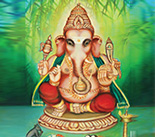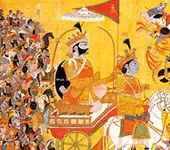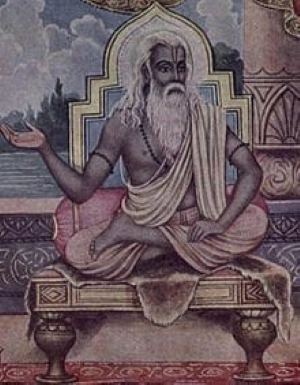There is a dog in the Swargaloka also. This discourse tells you about Sarama the divine dog.
Comments
Transcript
(Click here to read more)
We saw very briefly about the Parvas or sections of Mahabharata which are altogether a hundred in number and also that Mahabharata is not fiction. They are narrations of incidents of the past. Through the perspective of dharma. You can have several perspectives of the same incident. You can take sides on various issues. For example, if you take the Ayodhya dispute, you can take several perspectives. A legal perspective, a political perspective, a Hindu perspective, a Muslim perspective, a sensationalist perspective.....
Transcript
(Click here)
We saw very briefly about the Parvas or sections of Mahabharata which are altogether a hundred in number and also that Mahabharata is not fiction.
They are narrations of incidents of the past.
Through the perspective of dharma.
You can have several perspectives of the same incident.
You can take sides on various issues.
For example, if you take the Ayodhya dispute, you can take several perspectives.
A legal perspective, a political perspective, a Hindu perspective, a Muslim perspective, a sensationalist perspective.
Each perspective will be highlighting a certain aspect of the issue.
Here the perspective that Vyasa is giving is that of dharma.
These incidents may be differently described in other scriptures such as Puranas.
There may be other perspectives from a bhakti point of view as in Bhagavata.
So don’t get confused even if you are finding a different sequence or different kind of narration in other scriptures.
Now we will start with the Mahabharata itself.
So far, we were looking at the prologue and content pages.
The first Parva is Adi Parva, these are the main sections.
The sub sections are also called Parvas which we saw are hundred in number.
The Adi Parva has 233 chapters.
We have already covered two chapters and also two Parvas in this called the Anukramanika Parva and Parva Sangraha Parva.
Now we are going to start with the Paushya Parva which is also one chapter.
The third chapter, you must have heard about the Aarpa yajna of Janamejaya.
Here are some incidents which were a prelude to Sarpa yajna.
Why did Janamejaya do Sarpa yajna?
Who prompted him to do Sarpa yajna?
In the process, this chapter also reveals some important aspects related to guru-shishya relationship and also the kind of powers acquired through systematic learning in the gurukula sampradaya.
Janamejaya was doing a yajna in Kurukshetra along with his brothers.
It was a deerghasatra lasting a year.
You know who Janamejaya is, Pariskhit’s son.
Parikshit took over the reins of the kingdom from Yudhishthira.
He was the sole descendent of the Pandavas.
Even Parikshit would not have been alive, had it not been for the blessings of Lord Krishna.
Ashwathama had targeted Parikshit with Brahmastra while he was still in his mother’s womb.
Lord Krishna protected him from Brahmastra.
Pariskhit was eventually killed by Nagaraja Takshaka due to a curse.
His son Janamejaya is conducting this yajna in Kurukshetra along with his brothers.
The names of these brothers- Shrutasena, Ugrasena and Bhimasena.
There is a dog in Swarga called Sarama (सरमा).
She is also called Devashuni, the divine dog, a female dog.
Her son was Sarameya (सारमेयः).
There is a very interesting mention of Sarama in the Rigveda.
108th Sukta of the 10th Mandala starting with किमिच्छन्ती सरमा...
There was an Asura called Vala.
His soldiers stole the cows of Devaguru Brihaspati.
They took them away and kept them hidden in a cave.
Brihaspati sought Sarama’s help.
Indra asked Sarama to go and search for them.
She crossed a big river and reached Valapuram.
This river is in Antariksha, the name of this river is Rasa (रसा).
There in valapuram she spotted the cows.
By this time the Asuras, they also had another name Panis, they realized about the arrival of Surama and they wanted to strike a deal with her.
They realized that she was strong and determined.
She is not just going to go away like that.
They try to strike a conversation with her, with niceties:
How was your trip?
How was the water in the river?
Who are you?
Why have you come here?
This is not part of Mahabharata, ok?
Since Sarama’s name came up, I am quoting this directly from Rigveda
Sarama said: I am Indra's messenger.
I have come looking for Brihaspati's property which is here.
The water of the river in fact supported and protected me.
The Panis asked:
Who is Indra?
How big is his army?
Sarama said:
Indra is great.
This wide river will not be able to stop him.
Upon seeing him the river will run away towards the ocean in fear.
He will come and destroy you all.
You will all get killed by Indra.
We also have got sharp weapons, let us see who is going to take away these cows.
Sarama said: you people are not even worth a fight.
Panis said: these cows are ours now and they are well protected.
Nobody can take them away.
Sarama said: you don't know how powerful Devas are.
They will come here, crush you, and take the cows back.
Now is the most interesting part
Panis are saying to Sarama: anyway, since you have come here, why do you want to go back?
Be here with us, as our sister.
We will divide the cows between us.
Panis trying to bribe Sarama.
See bribing is nothing new.
And this is inborn for asuras.
First, they tried to resist, when they realized that the enemy is powerful, they are trying to bribe the messenger.
Don’t even go back, we will share the booty.
A thief telling a cop, let's share the booty.
Sarama says: I don’t know about brotherhood or sisterhood, but I know one thing for sure, Indra is very hard on his enemies.
You better run away from this place.
These cows are anyway going to be released and retrieved.
This is the character of Sarama, the divine female dog.
So truthful, so daring, so faithful.
Dogs are famous for their faithfulness.
They will never ever betray their master.
Now you know where this quality comes into the dog from.
They have taken after the divine dog, Sarama.
There are some people who look at dogs as some kind of impure animal.
Mind you, there is a dog in Swargaloka itself.
This is the kind of ignorance we have in our present-day society about dharma.
Even after so many examples- the dog is Bhairava’s vahana, you will find Dattatreya always with dogs.
When Lord Shiva appeared before Shankaracharya and gave him realization, there were dogs with him.
Brihatsamhita talks about the lakshana of dogs; like Ashwa Lakshana, Gaja Lakshana, signs in dogs that can bring fortune to the master.
Understand one thing, there is no place for hate in Sanatana Dharma, be it man or animal.
Sanatana dharma is all about love, compassion, kindness, sharing.
There is no place for hatred in Sanatana Dharma.
Yes, you should hate one thing, you should hate evil.
You should eliminate evil from inside and outside.
Sarama’s son Sarameya visited the yaga vedi of Janamejaya.
Recommended for you
Failure like success is also natural
 Click here to know more..
Click here to know more..
How Important Is Indra?

This discourse which is part of Mahabharata series tells you about- 1.The real nature and power of Indra. 2. The different strata of the universe.....
Click here to know more..Guru Paduka Smriti Stotram

प्रणम्य संविन्मार्गस्थानागमज्ञान् महागुरून्। प्रायश्....
Click here to know more..
English Topics
Mahabharatam
Click on any topic to open
- 96 Two Curses That Worked against Karna
- 95 What is behind Calling the Five Brothers the Pandavas
- 94 Give up an Individual IF....
- 93 Fascinating Birth Story of the Kauravas
- 92 Overcoming Grief - Lessons from King Senajit's story
- 91 Yayati's Wisdom
- 90 Yayati's Story
- 89 Brahmacharis Can Bless And Curse
- 88 Human Nature - Comples Mix Of Good And Bad
- 87 Results Of Good Karma
Please wait while the audio list loads..
30
Ganapathy
Shiva
Hanuman
Devi
Vishnu Sahasranama
Mahabharatam
Practical Wisdom
Yoga Vasishta
Vedas
Rituals
Rare Topics
Devi Mahatmyam
Glory of Venkatesha
Shani Mahatmya
Story of Sri Yantra
Rudram Explained
Atharva Sheersha
Sri Suktam
Kathopanishad
Ramayana
Mystique
Mantra Shastra
Bharat Matha
Bhagavatam
Astrology
Temples
Spiritual books
Purana Stories
Festivals
Sages and Saints
